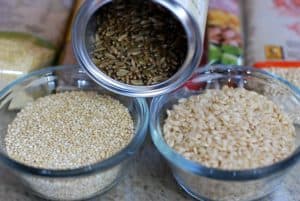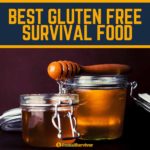A while back, we did a very in-depth look at the top emergency food brands. We looked at nutrition, shelf life, packaging, quality, cooking method, convenience, cost, and taste (because you shouldn’t have to eat tasteless crap just because of SHTF!).
One thing we didn’t look at in that post was gluten-free survival foods. Since so many people have gluten allergies, I thought it was time to address that here.
Related: Best Organic Emergency Food
Problems You’ll Face Finding Gluten-Free Survival Food
It is tough finding gluten-free foods in regular times, never mind in a long-term SHTF situation. Gluten is in just about everything.
The good news is that many brands now have separate categories for gluten-free emergency food and meals. If you are building your emergency food stockpile from just freeze-dried meals, you can buy a bunch of gluten-free options and be done.
But, as we’ve discussed, you should have various emergency foods in your stockpile.
This includes:
Canned goods
Bulk foods (such as rice, beans, and oats)
Freeze-dried meals
The canned goods are probably obvious (though you will want to read this post for insights on things you might have overlooked about canned food). So, instead, I’m going to talk about gluten-free bulk foods and freeze-dried meals here.
Bulk Options
The cheapest way to build up an emergency food supply is to buy bulk foods (such as 25lbs of rice) and seal them yourself in Mylar bags with oxygen absorbers. Those bags then go in a bucket to keep them safe.
You can read detailed instructions on how to use Mylar bags here.
While cheap, this method is not the easiest.
Whether you have a gluten allergy or not, you’ll need to:
- Figure out what sort of meals you could make out of bulk ingredients
- Carefully calculate how much of each ingredient you need
- Decide how to package those ingredients (such as putting rice in 5-gallon bags but dried onions in 1-quart bags)
- Do the packaging yourself
See this post for more information on how to plan emergency food (including how many pounds of each food type to get, meal plan examples, and cost breakdown).
Gluten-free foods you can buy in bulk:
Rice
Beans and legumes
Tapioca
Potato flakes
Dehydrated fruits and vegetables
Dried milk powder
Honey
Sugar
*Note that almost all emergency food companies have buckets of food you can buy. This is much more convenient than packing them yourself.
The fruit, veggie, milk, and egg buckets are *usually* gluten-free.
The thing you need to watch out for is meat buckets. Some brands add coatings to the meat which contain gluten! I’d recommend getting non-meat food buckets from Augason Farms – they are affordable and GF.
For meat buckets, go with Valley Food Storage, as they are the most affordable but still of good quality.
Buy:
- Veggie can from Augason Farms
- Fruit bucket from Augason Farms
- Milk bucket from Augason Farms
- Egg powder from Augason Farms
- Meat bucket from Valley Food Storage
What about Gluten-Free Flour and Grains?

Most guides recommend storing wheat berries for emergency preparedness. That is out of the question if you’ve got a gluten allergy. However, there are plenty of other grains that you could store.
The bad news is that gluten-free flour mixes aren’t suitable for long-term storage. Grains have shells around them, which naturally protect them from going bad. Once you remove that shell to make flour, the grain starts going bad very quickly. This is why whole grains can be stored for 20+ years, but flour generally only lasts 1-5 years.
Another issue is that some grains contain lots of natural oils. These oils will cause the grain to go bad quickly (no matter how well you package them). That is why brown rice is NOT suitable for long-term storage, but buckwheat is.
Gluten-Free Grains Shelf-Life*
*Stored in sealed Mylar bags with oxygen absorbers
| 1-5 Years | 8 years (edible up to 20 years) | 10-12 years (edible 30+ years) |
|---|---|---|
| Gluten-free flour mixes Brown rice | Quinoa Oats | Dry corn Buckwheat Millet Amaranth Flax |
Note that I couldn’t find any information about the long-term shelf life of sorghum or teff. They have a low oil content and hard shells, so I’d expect them to last at least 8 years. I’m not promising anything, though!
(Sources: USA Emergency Supplies, Grain Maker)
Gluten-Free Emergency Meal Kits
Pouches of freeze-dried meals can be expensive. However, you can get a much better deal if you buy the meals as part of a bigger kit. Lots of companies are now offering GF meal kits – including these:
Valley Food Storage Gluten Free

Valley Food Storage was chosen as “best overall” in our top emergency food companies review. Both their bulk foods and freeze-dried meals are affordable. They also do well in terms of nutrition. Their products are GMO-free and have less sodium than most other brands.
As for gluten-free meal kits, they don’t have any, but they have individual options that can be combined to make a decent gluten-free meal.
- Get this if: You want affordable, healthy meals.
Legacy Food Storage Gluten-Free Meal Kits

Legacy Food Storage is the best for giving you lots of calories per meal. They have a lot of gluten-free kits. The 120-serving kit, for example, contains 8 different entrees.
- Get this kit if: You want a good variety of filling entrees.
Wise Food Storage Gluten Free Kits
Wise Food Storage has a GF entrée kit with 84 servings. The downside is that the kit doesn’t contain too much variety. There are only 4 different entrees and yogurt. So, I don’t recommend it!
However, I would recommend their buckets of powdered eggs, veggies, meat and rice, milk, and fruit.
- Get this kit if: You are already buying food buckets from Wise.
Read our in-depth review of Wise Company
Gluten-Free Emergency Meals Pouches
Here’s a list of gluten-free meals from the top emergency food brands. I haven’t tried all of these myself, so I can’t attest to what they taste like. They are listed in no particular order.
*DF = Dairy Free
Valley Food Storage
- Strawberry Oatmeal
- Apple Oatmeal
- Sweet and Sour Asian Rice
- Irish Pub Cheddar Potato Soup
- Chicken Teriyaki –DF
- Enchilada Beans and Rice –DF
- Tomato Basil Soup
Mountain House
Mountain House emergency meals are pricier than other brands. However, they are one of the few brands which contain real meat in their meals. They also taste better than most other emergency meals.
From Legacy Food Storage
Legacy has lots of GF meals, but they can only be purchased as part of a kit. See the kit here.
- Enchilada, beans, and rice
- Cheese and broccoli bake
- Cream A La King
- Cheese and broccoli soup
- Vegetable and rice soup mix – DF
- Potato soup mix – DF
- Classic chili – DF
- White bean chili
From Wise Food Storage
Wise primarily sells its products as part of bulk sets. However, you can buy some meal options individually.
Backpacker’s Pantry
This brand is very popular with backpackers. They have a lot of gluten-free freeze-dried meal pouches. Plus, many of their meals are also dairy-free. If you like lots of flavor in your food, then this is the brand to go with. They are pricier than some other options but worth it in terms of the quality of ingredients and taste.
- Santa Fe black beans and rice with chicken – DF
- Pad Thai with chicken
- Jamaican jerk chicken
- Chana masala – DF
What about GF with Other Dietary Restrictions?
If you are GF and have an allergy to soy or milk, your best bet is to look for “paleo” meals. The paleo diet excludes virtually all common allergens (eggs are allowed).
Elements Meals and Wild Zora are the only brands I know of that make paleo emergency meals. If you know of other options, please let us know in the comments!
These options are pricier, but the quality is far superior. Not only are you getting real meat (instead of “meat flavor”), but you are getting real ingredients, lots of protein, and no artificial fillers.
Wild Zora Paleo Meals (GF, DF, grain-free, soy-free, sugar-free)
- Palisade pineapple mango
- Summit Savory Chicken
- Mountain beef stew
- Cliffside coconut berry
- Caldera chicken curry
- Butte cacao banana
- Meal Packs




Some of us who are gluten and dairy intolerant are also allergic to nightshade family vegetables. For me, that means no tomatoes or tomato sauce , bell peppers, etc. and even potatoes which makes finding variety in emergency meals very difficult. I also wish someone would make 72 hour dense energy bars that are gluten free (and that have longer shelf life)
Very Informative. Will look into these possibilities later. Thanks
Are the “special diet” foods in single serving? We are a family of 3, I am the only special diet, GF DF
Look at the list of pouches. Even the ones that have “multiple servings” usually only contain enough calories for one person.
This and the comments were really helpful thank you!!
There are two additional food-related issues that are common comorbidities with Gluten intolerance and particularly with celiac disease; Oat intolerance and lactose intolerance.
The former is caused by the significant similarity between the component of gluten that the immune system reacts to and a similar protein found in oats. Therefore “gluten-free” oats are contraindicated for many people with celiac disease.
Lactose intolerance occurs with a much higher frequency in individuals with celiac disease than the general population, and it can have an onset at any point during their lifetime. A past in which dairy products were readily absorbed does not predict the future, and the time from onset of symptoms to the point at which a lactose-free diet is required in order to survive can be quite short. Therefore, products containing dairy components should also be avoided when preparing a gluten-free stockpile of survival foods.
It would be helpful if this information was taken into account when advising regarding suitable sources of gluten-free survival foods.
Thanks and keep up the good work!
Thanks for the comment. Yes, there are a lot of issues to think about when making an emergency food stockpile for allergies and intolerances. We know this article is just a starting point.
My daughter has a gluten allergy as well as allergy to chicken and eggs. I have noticed many of these places use chicken fat and chicken as flavoring in their gluten free meals. What is the best way to get nutritious but safe meals to store for her?
You’ll probably have to build them from scratch (which is cheaper and a lot healthier than most pre-made survival meals). I suggest making a spreadsheet and calculating how much of each type of food you will need (carbs, proteins, fruits, veggies, fats, dairy or alternatives…). Then work on getting these foods and packaging them yourself. I go over this all in detail in my book Disaster Preparedness for Women. It’s got examples of spreadsheets complete with calorie tallies (plus loads of other info on prepping). You can get the book here if you are interested: https://amzn.to/2WbXZoZ
Best place to get oxygen absorbers and how to use them?
Hi Meredith – we have an excellent post about mylar bags and oxygen absorbers which should help.
What about NuManna brand GF?
No experience of this brand – would you recommend it?